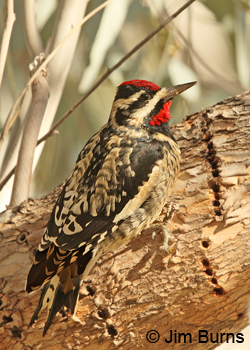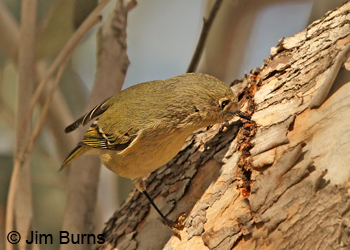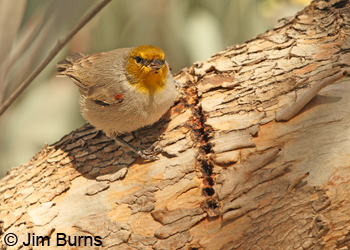|
|
|
Shoppers at the Winter Supermarket |
Last month, while looking for the quiet, retiring, male Yellow-bellied Sapsucker near the Eucalyptus Grove at Boyce Thompson Arboretum State Park (BTA), I chanced upon a row of new wells he had dug this year and was actively maintaining. This was a stroke of luck, not only because he himself was returning to this same branch every twenty minutes, but because it also gave me an opportunity to observe a steady stream of avian interlopers feeding at his digs.
As most of you are undoubtedly aware, Yellow-bellied Sapsucker is considered an “eastern” species, though like many such designees, it should not be a surprise when one turns up in winter in the west since its breeding range extends westward across the Canadian forestlands into Alaska. Because I’ve had zero personal experience with this species’ natural history, my recent afternoon at BTA prompted some searching through the literature which corroborated my observation that many other avian species utilize Yellow-bellieds’ wells, both for the nutritional sap itself and to glean insects attracted to and trapped in the gooey fluid.
In my three hour vigil near the wells I counted a dozen different visitor species including hummingbirds, two other species of woodpecker, Verdins, wrens, kinglets, two species of warblers, House Finch, and Lesser Goldfinch. The most regular customers were a female Anna’s Hummingbird, a Verdin, and a Ruby-crowned Kinglet. Although I saw all three insert their bills into the wells, I could never tell whether sap or insects was the main attraction. Sapsuckers lick the sap with brushy modifications on their tongues, dip attendant insects into the sap for added nutritional value, and also eat the cambium layer of the inner bark itself.
One Yellow-bellied study indicates that up to 70% of their wintertime daily activity is spent on sap well construction or foraging around their sap well circuit. Despite this large work investment, I observed no interspecific action between the sapsucker and the others, though the literature indicates that on their breeding territory all four Sphyrapicus woodpeckers staunchly defend their wells. My guess here is that all the species I observed, with the notable exception of the Gila Woodpeckers, are smaller than the sapsucker, wisely employed eat and run tactics, and never came to the table when the host himself was present.
A fascinating footnote to the breeding territory ecology of Yellow-bellied Sapsuckers is their apparent commensal relationship with Ruby-throated Hummingbird. The eastern hummer is known to build its nest near sap wells, follow the sapsuckers on their circuit and perhaps even time their migration to that of the woodpeckers. A parallel relationship seems to exist in the west between Red-naped Sapsucker and Rufous Hummingbird.
Yellow-bellied Sapsucker wells have been recorded in 1000(!) different species of woody plants, eclectic opportunism at work. It’s no wonder that the BTA Yellow-bellied’s favorite trees are Australian Coolibahs, members of the Eucalyptus family. How ironic that an unexpected visitor from the east has chosen an exotic tree from the Far East in which to open a food source that helps our native Arizona western birds thrive through the winter.


